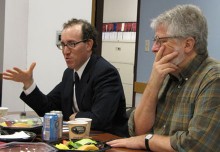
February 22, 2011 — At a Shorenstein Center event, “From the Front Lines to Online,” Joel Simon, executive director of the Committee to Protect Journalists (CPJ), looked at the past year in press freedom. He focused on CPJ’s recent publication of Attacks on the Press, a worldwide survey of the mistreatment of journalists in 2010.
In the survey, the CPJ discovered several trends, Simon noted. One is that “Pakistan was the world’s most deadly country for the press last year.” However, Simon pointed out, “most of the journalists killed in Pakistan were victims of suicide attacks in which they were not the direct targets.”
China and Iran top the list of countries with the most journalists taken prisoner, Simon stated, a “troubling trend.” In Latin America, “censorship is making a return,” he added. “Judicial censorship” characterizes the government in Brazil, and “political figures … who bring libel action can also get the court to grant injunctions against further coverage of their activities.” In fact, Brazil has the “highest incidence of takedown of web content.”
While social media has been getting a lot of credit for revolutions across the world, Simon noted that it is a more “complex issue,” and that it “cuts both ways.” Social media is “great for constructing networks, but it is also great for dismantling networks,” he said. For example, the “Iranian government engaged in crowd-sourcing of protesters,” and “infiltrated and trapped people using Facebook.”
Simon acknowledged that Twitter had an impact in Egypt: “It might not have been a Twitter revolution for Egyptians, but it was definitely a Twitter revolution for journalists.” Twitter allowed CPJ to document instances of journalists’ tweets and to respond “in real time.” It “transformed the way [CPJ] reported,” and it also transformed “the way that … people followed events,” he explained.
Simon recognized that there is an increasing number of journalists who work online who have been imprisoned and killed. “As journalism converges online,” he said, “the future of press freedom is online, and keeping the Internet free as a platform for journalism is where the battle is now.”
This article was written by Janell Sims and the photos taken by Leighton Walter Kille, both of the Shorenstein Center.

